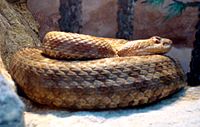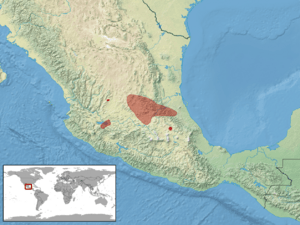Querétaro dusky rattlesnake facts for kids
The Querètaro Dusky Rattlesnake (Crotalus Aquilus) is a type of venomous snake. It's also called the "Vibora de cascabel" by people in Mexico. This snake is a pit viper, and it usually lives in the high lands of central Mexico. Its scientific name, Aquilus, comes from a Latin word meaning "eagle". This name fits because the snake lives in high, mountainous areas, like where eagles might fly. This rattlesnake isn't very well known around the world, but people in Mexico know a lot about it.
Quick facts for kids Querètaro Dusky Rattlesnake |
|
|---|---|
 |
|
| Scientific classification | |
| Kingdom: | |
| Phylum: | |
| Subphylum: | |
| Class: | |
| Order: | |
| Suborder: | |
| Family: | |
| Subfamily: | |
| Genus: | |
| Species: |
C. Aquilus
|
 |
|
Contents
What Does the Querètaro Dusky Rattlesnake Look Like?
Adult Querètaro Dusky Rattlesnakes are usually about 50 centimeters (20 inches) long. Some can grow a bit longer, up to 67.8 centimeters (26.7 inches).
These snakes come in different colors. They can be green, yellow, dark gray, or dark brown. They also have dark brown or black blotches, which are like big spots, on their bodies.
Where Do These Rattlesnakes Live?
The Querètaro Dusky Rattlesnake mainly lives in the high lands of central Mexico. You can find them in places like pine-oak forests and grasslands. They also live on grassy hills and mountains.
These snakes are found in several Mexican states. These include Guanajuato, Hidalgo, México, Michoacán, and San Luis Potosí.
What Do Querètaro Dusky Rattlesnakes Eat?
The Querètaro Dusky Rattlesnake mostly eats lizards. But they also enjoy eating frogs. They hunt and eat many different kinds of rodents too.
Younger rattlesnakes, called juveniles, have a slightly different diet. They also eat insects, which helps them grow big and strong.
Understanding the Querètaro Dusky Rattlesnake's Venom
This rattlesnake is a venomous pit viper. This means it can produce venom, which is a type of poison. If a human is bitten, the venom can cause harm.
The venom of the Querètaro Dusky Rattlesnake is called hemotoxic. This means the venom mainly affects the blood in a person's body. It can damage blood cells and tissues.
However, these snakes do not often bite people. They prefer to be left alone and are not aggressive. A Querètaro Dusky Rattlesnake will usually only bite a person if it feels attacked or bothered. It's their way of defending themselves.
See also
 In Spanish: Cascabel de Querétaro para niños
In Spanish: Cascabel de Querétaro para niños

